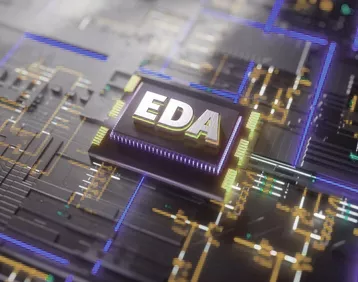
Bridging the Frontier Bob Smith, Executive Director
Bob Smith is Executive Director of the ESD Alliance responsible for its management and operations. Previously, Bob was senior vice president of Marketing and Business Development at Uniquify, responsible for brand development, positioning, strategy and business development activities. Bob began his … More » Griffin Securities’ Jay Vleeschhouwer and Wall Street’s Current View of EDA IndustryNovember 15th, 2023 by Bob Smith, Executive Director
 Note: Last week, my SEMI Q&A blog post with Charles Shi, principal and senior analyst at Needham & Company, was republished here. This week, I turn to Jay Vleeschhouwer, managing director of software research at Griffin Securities, for his perspective from another Q&A blog post that appeared recently on SEMI. Jay Vleeschhouwer is a knowledgeable EDA industry follower in his role as a financial analyst and has tracked the EDA industry for more than 25 years.I spoke with him recently for his insights on the state of electronic design automation (EDA), the topic of his presentation at the 2023 Design Automation Conference (DAC). Smith: After many years of single-digit growth, the EDA industry has accelerated to growth rates in the double-digits. What are the key drivers behind this trend? Vleeschhouwer: The industry has accelerated and growth has moved into double digits for the last number of years. Our forecast for 2023 is that we’ll have another double-digit growth year to about $13 billion from more than $11.5 billion in total industry revenue last year. EDA product and engineering requirements are driven by multiple catalysts. The EDA industry has been around for four decades and it’s always been used for automating design and enhancing productivity, for doing tasks that cannot be done manually owing to the complexity of semiconductor design and implementation.
This is apparent from the industry data. In the late 90s, industry growth was narrowly based among a few product categories. As implementation requirements began growing in the early 2000s, customers had to employ a larger set of increasingly integrated tools. This led to broad growth across multiple tool categories, a different situation from the beginnings of the EDA industry. This trend of multiple tools and integration is important to the momentum and financial health of the industry and is driven by the complex technical requirements of leading-edge semiconductor design. One of the most important structural and competitive changes that began roughly two decades ago was when Cadence and Synopsys responded to customer requirements by broadening their offerings and becoming increasingly alike in their product portfolios. This was evident by Synopsys’ acquisition of Avant! and many of the Cadence acquisitions. Another example of this structural change is Magma Design Automation in the early 2000s. It had the right place and route solution for the right problem at the right time, until Cadence and Synopsys became increasingly competitive. Ultimately, Synopsys acquired Magma. The cumulative result of the massive technical integrations across toolsets coupled with numerous acquisitions by Ansys, Cadence, Synopsys and Siemens EDA (the Big Four) is consolidation. In the EDA industry, the Big Four now account for about 90% of industry revenue, far more concentrated than in other software industries that we cover. This concentration has financial implications in terms of pricing and profitability.
The EDA companies’ margins, specifically Cadence’s and Synopsys’, have materially increased to the mid 30% or better and are sustainable, with positive cash flow. In turn, that further increases the market values for EDA stocks. Looking back over the last decade, the period when we began recommending EDA stocks, the increase in EDA market caps has been approximately tenfold or more, a remarkable increase. Similarly, the price-to-earnings ratios have gone up, as have the ratios of enterprise value to revenue. Those metrics have improved and are now stable characteristics of those two companies. Smith: Do you expect this double-digit growth and profitability will continue without the big fluctuations we see in the semiconductor market that goes through historical boom and bust periods? Vleeschhouwer: The best we can foresee for this year, maybe into next year, is that EDA has at least another year of double-digit growth. We expect to see mid-teens growth in terms of revenue from both Cadence and Synopsys in 2023. The big variable in the total industry results is Siemens EDA, formerly Mentor Graphics. Its business has grown considerably – by about half since the acquisition of Mentor by Siemens in 2017. All else being equal, it has the most variable revenue because Mentor operated on a mostly upfront license model. Compared to Cadence and Synopsys, Siemens EDA has proportionately the smallest amount of subscription revenue, which is generally a more stable model that grows more smoothly, with less variability. At Siemens EDA, the variability is tied to the timing and magnitude of contract renewals for its physical verification and printed circuit board design (PCB) businesses, less so for the emulation and prototyping hardware business.
When looking at the Siemens EDA numbers, we consider the numbers on a two- or three-year comparative basis by comparing the most recent quarter with the same quarter two years ago or three years ago to average out the growth. That tends to smooth out the variability. Clearly there’s underlying growth. Siemens EDA business has grown by about half since 2016, the final year that Mentor reported and the company continues to dominate in physical verification and PCB. From the EDA data, it’s clear that physical verification has been a large category and growing over the years, as has PCB. In terms of your original question on industry variability, that’s part of it. Outside of the core EDA software business is an inherent variability of the IP (semiconductor intellectual property) business and hardware-assisted-verification business, even during a great environment when there are no concerns about the economy. Variability in IP revenue exists since the accounting rules require recognition of much of the licensing revenue as up-front. Hardware is typically based on non-recurring revenue and is also a growing category. No one would have imagined 20 years ago that hardware or IP, not necessarily financially attractive at that time, would surpass a billion dollars each in annual revenue. IP is now a $2 billion category. That’s a long-term growth trend line, around which there is going to be inherent variability because revenue recognition is tied to the consumption of the product. Smith: I read the announcement that Synopsys is teaming up with Intel to supply its foundry operations with IP, which would have been unimaginable 15 or 20 years ago. Vleeschhouwer: You bring up a good point, because Intel has been Synopsys’ largest customer for the past two decades. Intel has accounted for more than 10% of Synopsys’ revenue every year since 2004.
Synopsys’ fiscal 2017 and fiscal 2018, included two back-to-back years of $100 million increases in revenue from Intel, likely attributable to increased hardware sales. In fiscal 2022, based on disclosures in Synopsys’ annual report, Intel’s revenue to Synopsys set a record, increasing by approximately $150 million. Hardware has become a much larger category in the semiconductor design industry and customers including Intel now consume hardware in substantial quantities as designs are becoming increasingly more complex. Smith: The definition of the democratization of chip design is open-source software solutions for tools and IP. RISC-V is a good example. Our industry has an ongoing talent shortage. The result of open source could be more people learning how to do chip design. Some critics view it as a threat. Do you see where this would have measurable impact on what’s going on in the EDA software business? Vleeschhouwer: Democratization is a word that has also been applied in the other side of Engineering Software, specifically with respect to simulation in the industrial and manufacturing markets like aerospace and automotive. Historically, simulation has been largely used by a small, highly trained and specialized set of users. When we look at non-EDA simulation over the last 20 years, the growth of that industry started to accelerate and the profile changed. Clearly, simulation has grown substantially in its core markets and beyond. Does that translate into a vast army of users? Not necessarily. In the mechanical computer automated design (CAD) market, the number of simulation users remains a fraction of the number of CAD users, which is well over a million.
The parallel in the EDA world is integration to solve multiple variables. Even though EDA has been growing in double digits and effectively doubled in a relatively short period of time, the number of users has not doubled. Using a simple metric, the average revenue per employee and the average revenue per customer have gone up because revenue has been increasing faster than the number of individual users. More licenses are being used per user and pricing has gone up. EDA companies have more pricing power than they had 20 years ago. I tend not to be an adherent to the democratization notion of EDA. It would be more relevant in the non-EDA side of Engineering Software because of the larger number of customers. In EDA, we’re talking about a relatively small number of companies in terms of revenue, maybe a few hundred. In the manufacturing and industrial world, tens of thousands of customers span the multiple end-markets. If anything, democratization would more likely be in that part of Engineering Software, given the greater scale of the customer base than EDA, which continues to be a concentrated specialization. Smith: You talk about Engineering Software starting to converge with EDA. Do you think this will continue and, if so, how will it change the industry in terms of growth and profitability? Do you expect to see more consolidation and or more collaborations across the industry? Vleeschhouwer: You’re referring to the theme of the panel the first day of Design Automation Conference with Ansys, Cadence, Dassault, PTC and Siemens, a theme that didn’t suddenly occur. It’s been something in the air for years and only recently technological, customer or market-driven reasons make it more compelling. It is beginning to be manifested in company portfolio strategies. Two companies that best exemplify this theme are Siemens and Ansys. They combine elements of non-EDA and EDA in their portfolios and the partnership between Cadence and Dassault is an acknowledgement. The two companies were obviously aware of each other before the formal relationship and had discussions going back to the early 2000s. Ansys has multiple relationships across the industry. It’s fascinating to see its relationships with PTC, Synopsys and Autodesk are all simulation-centric. There are two arms races in technology. One is software development and that has been manifested in the AI arms race. The second is a silicon arms race, which is related to the first in part, but it’s been ongoing for several years because of what’s going on with automotive, consumer electronics, communications and data centers. Ansys has put together an ecosystem that demonstrates that the convergence between EDA and the rest of Engineering Software is part of an overall arms race in technology. Smith: Do you see EDA encroaching into the broader areas of Engineering Software? Vleeschhouwer: Perhaps implicit in your question is what Cadence is doing with its Intelligent System Design or ISD strategy and its ambitions in the automotive and aerospace markets. At Cadence, that’s been manifested with acquisitions in some new, not purely EDA areas such as physics with acquisitions of computational fluid companies such as Numeca and PointWise. So, yes, it is evident that some point tools are being offered for non-EDA applications. If I interpreted your question correctly, Cadence is clearly strategically focusing on moving into adjacent areas to EDA. It has to start somewhere with point tools and have a more unified data platform. Cadence certainly exemplifies the move beyond EDA. By the same token, Siemens exemplified that strategy by accumulating properties across the EDA and Engineering Software spaces. |
|
|
|||||
|
|
|||||
|
|||||


 The inexorable scope and scale of complexity coupled with the need for multivariable optimization within semiconductor and electronic systems design creates a growing interdependency among multiple tool categories needed for design flows and to effectuate designs.
The inexorable scope and scale of complexity coupled with the need for multivariable optimization within semiconductor and electronic systems design creates a growing interdependency among multiple tool categories needed for design flows and to effectuate designs. Not only has EDA industry revenue accelerated, an outgrowth of recent semiconductor R&D acceleration, EDA companies have also reported a massive structural improvement in their profitability, which is reflected in their operating margins. In the past, they were below those of the counterpart companies in Engineering Software or technical software companies such as Dassault, PTC and Autodesk that have higher margin structure on average.
Not only has EDA industry revenue accelerated, an outgrowth of recent semiconductor R&D acceleration, EDA companies have also reported a massive structural improvement in their profitability, which is reflected in their operating margins. In the past, they were below those of the counterpart companies in Engineering Software or technical software companies such as Dassault, PTC and Autodesk that have higher margin structure on average. This has been characteristic of the Mentor/Siemens model for years and will be a considerable variable in what the final industry revenues turn out to be. In the first quarter of this year, for example, it looked like Siemens EDA revenues were up approximately 9% versus a mid-20% decline last year. On the other hand, in the June 2023 quarter, it didn’t give a precise number, but we have derived an approximate 15% decline year-over-year versus a 20% increase the year before. In absolute terms, it looks like the second calendar quarter was nearly the same sequentially as the first calendar quarter. Basically, flat sequentially, but considerably variable on a year-over-year basis.
This has been characteristic of the Mentor/Siemens model for years and will be a considerable variable in what the final industry revenues turn out to be. In the first quarter of this year, for example, it looked like Siemens EDA revenues were up approximately 9% versus a mid-20% decline last year. On the other hand, in the June 2023 quarter, it didn’t give a precise number, but we have derived an approximate 15% decline year-over-year versus a 20% increase the year before. In absolute terms, it looks like the second calendar quarter was nearly the same sequentially as the first calendar quarter. Basically, flat sequentially, but considerably variable on a year-over-year basis. Intel is by far the largest commercial spender on EDA software and a large consumer of hardware. The largest part of that is going to Synopsys, though it has increased its spending with Cadence.
Intel is by far the largest commercial spender on EDA software and a large consumer of hardware. The largest part of that is going to Synopsys, though it has increased its spending with Cadence. Is that democratization? No. It’s just an expansion of a market due to compelling technical and business reasons. One of the reasons is the exogenous effect of massively cheaper compute power while another is the endogenous effect of increasingly powerful, higher capacity, easier to use software that is increasingly integrated across multiple physics.
Is that democratization? No. It’s just an expansion of a market due to compelling technical and business reasons. One of the reasons is the exogenous effect of massively cheaper compute power while another is the endogenous effect of increasingly powerful, higher capacity, easier to use software that is increasingly integrated across multiple physics.



